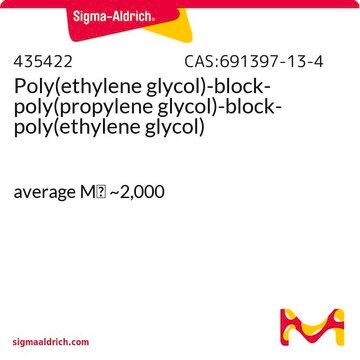202339
Poly(propylene glycol)
average Mn ~2,000
Sinónimos:
PPG, Poly(propylene oxide)
About This Item
Productos recomendados
vapor density
>1 (vs air)
vapor pressure
<0.01 mmHg ( 20 °C)
mol wt
average Mn ~2,000
contains
130-190 ppm proprietary phenolic antioxidant
refractive index
n20/D 1.451
viscosity
300 cSt(25 °C)(lit.)
hydroxyl value
56 mg KOH/g
density
1.005 g/mL at 25 °C
SMILES string
CC(O)CO
InChI
1S/C6H14O3/c1-5(8)4-9-6(2)3-7/h5-8H,3-4H2,1-2H3
InChI key
DUFKCOQISQKSAV-UHFFFAOYSA-N
¿Está buscando productos similares? Visita Guía de comparación de productos
General description
Application
- Corrosion inhibitor for mild steel in acid solution.
- Starting material to synthesize epoxy resin/polyurethane hybrid networks via frontal polymerization.
Storage Class
10 - Combustible liquids
wgk_germany
WGK 1
flash_point_f
445.0 °F - closed cup
flash_point_c
229.44 °C - closed cup
ppe
Eyeshields, Gloves
Certificados de análisis (COA)
Busque Certificados de análisis (COA) introduciendo el número de lote del producto. Los números de lote se encuentran en la etiqueta del producto después de las palabras «Lot» o «Batch»
¿Ya tiene este producto?
Encuentre la documentación para los productos que ha comprado recientemente en la Biblioteca de documentos.
Los clientes también vieron
Nuestro equipo de científicos tiene experiencia en todas las áreas de investigación: Ciencias de la vida, Ciencia de los materiales, Síntesis química, Cromatografía, Analítica y muchas otras.
Póngase en contacto con el Servicio técnico








